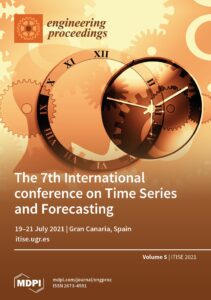The Indo-Burman arc is the boundary between the India and Burma plates, north of the Sumatra–Andaman subduction zone. The existence of active subduction in the Indo-Burman arc is a debatable issue because the Indian plate converges very obliquely beneath the Burma plate. Recent GPS measurements in Bangladesh, Myanmar, and northeast India indicate 13–17 mm/y of plate convergence along a shallow dipping megathrust while most of the strike-slip motion occurs on several steep faults, consistent with patterns of strain partitioning at subduction zones.
More“Modelling the seismic potential of the Indo-Burman megathrust”Joint ICTP-IUGG Workshop on Data Assimilation and Inverse Problems in Geophysical Sciences
There is the Workshop on Data Assimilation and Inverse Problems in Trieste Italy. It started on 18 October and will end on 29 October 2021.
The workshop organized jointly by the International Union of Geodesy and Geophysics (IUGG), ICTP, and EAIFR will discuss applications of data assimilation and inverse problem methodologies to specific geophysical fields. The related scientific progress may contribute to the solutions of major societal challenges, such as climatic and environmental changes, disaster risk reduction, and sustainability.
You can still join the Workshop and listen to lectures from world leading scientists.
On the seismic potential of the Corsica–Sardinia block
The Corsica–Sardinia lithospheric block is traditionally viewed as a region of notoriously low seismicity. Earthquake catalogs report only three moderate earthquakes in the range of magnitudes 5.0–5.1. The scarcity of documented seismicity in the region does not allow for the reliable assessment of the seismic hazard. In this paper, we make an attempt to evaluate the seismic potential of the Corsica–Sardinia region employing the morphostructural zoning (MSZ) that allows for the identification of locations of potential earthquakes.
More“On the seismic potential of the Corsica–Sardinia block”Alexander Anatolievich Soloviev passed away
 This sad event came as a huge surprise to us. Pain and sorrow overwhelm the hearts of everyone who knew Alexander Anatolievich Soloviev… Integrity and a good attitude to people were his hallmarks and left deep impression on everyone who knew him. We are devastated to have lost a wonderful man, talented scientist, wise mentor, colleague, friend…
This sad event came as a huge surprise to us. Pain and sorrow overwhelm the hearts of everyone who knew Alexander Anatolievich Soloviev… Integrity and a good attitude to people were his hallmarks and left deep impression on everyone who knew him. We are devastated to have lost a wonderful man, talented scientist, wise mentor, colleague, friend…
Space analyticity and integral bounds for solutions to equations of magnetohydrodynamics
In the paper “Space analyticity and bounds for derivatives of solutions to the evolutionary equations of diffusive magnetohydrodynamics”, V. Zheligovsky has given solutions to the three following mutually related problems:
– to carry over the known a priori bounds for arbitrary-order space derivatives of solutions to the Navier–Stokes equation to space-periodic solutions to the equations of diffusive magnetohydrodynamics;
– to derive similar a priori bounds for arbitrary-order space derivatives of the first-order time derivative of the Fourier–Galerkin approximants of the MHD solutions and to prove that the bounds are admitted by weak solutions to the equations of magnetohydrodynamics;
– to reveal a link between these bounds and space analyticity of the MHD solutions at almost all times.
More“Space analyticity and integral bounds for solutions to equations of magnetohydrodynamics”Asymptotic Distributions of M-Estimates for Parameters of Multivariate Time Series with Strong Mixing Property
 The article «Asymptotic Distributions of M-Estimates for Parameters of Multivariate Time Series with Strong Mixing Property» was published in «Engineering. Proceedings» and presented at the 7th International conference on Time Series and Forecasting, Gran Canaria, Spain, 19-21 July 2021. Authors – A. Kushnir and A. Varypaev.
The article «Asymptotic Distributions of M-Estimates for Parameters of Multivariate Time Series with Strong Mixing Property» was published in «Engineering. Proceedings» and presented at the 7th International conference on Time Series and Forecasting, Gran Canaria, Spain, 19-21 July 2021. Authors – A. Kushnir and A. Varypaev.
The paper investigates the asymptotic properties of statistical estimates for the vector parameter \mathbf{u} \in R^q of a multidimensional random time series z_{t} \in R^m , t \in \mathbb{Z} , satisfying the strong mixing conditions. The authors have considered estimates \widetilde{\mathbf{u}}_{n}(\overline{z}_{n}) that are solutions of the equations \bigtriangledown_{\mathbf{u}}Q_{n}(\overline{z}_{n};\mathbf{u}) = 0, \overline{z}_{n} = (z^T_{1},...,z^T_{n})^T, where Q_{n}(\overline{z}_n;\mathbf{u}) are some objective functions for which \bigtriangledown_{\mathbf{u}}Q_{n}(\overline{z}_{n};\mathbf{u}) satisfies some constraints. It was proved, that under these constraints, the estimates \widetilde{\mathbf{u}}(\overline{z}_{n}) are \sqrt{n} – consistent and asymptotically normal with a limit covariance matrix \mathbf{D(u) = \Phi^{-1}(u)\Psi(u)\Phi^{-1}(u)} uniquely determined by the objective functions Q_{n}(\overline{z}_{n};\mathbf{u}).
The results of this paper are a generalization of the methods for constructing and analyzing the asymptotic properties of M-estimates, which were previously studied for the case of independent identically distributed observations.
Source: Kushnir, A.; Varypaev, A. Asymptotic Distributions of M-Estimates for Parameters of Multivariate Time Series with Strong Mixing Property // Eng. Proc. 2021, 5, 19. 10.3390/engproc2021005019
Earthquake Prediction: Old Expectations and New Results
It is known that there is no satisfactory physical model of earthquakes. The paradox of seismicity is known, according to which the implementation of seismic slip according to the generally accepted Reid`s elastic rebound model, due to the corresponding values of temperature and pressure, cannot occur at depths of more than several tens of kilometers. To get around these difficulties, models were proposed for the role of the fluid phase and various types of metamorphic transformations in the occurrence of deeper earthquakes.
More“Earthquake Prediction: Old Expectations and New Results”
